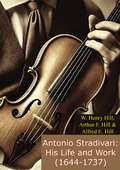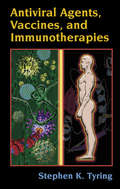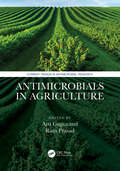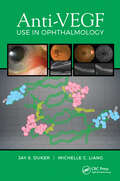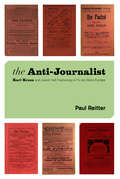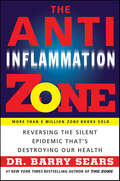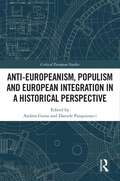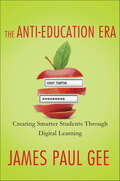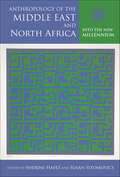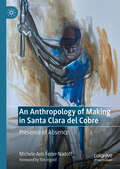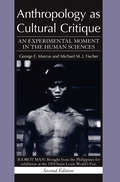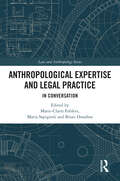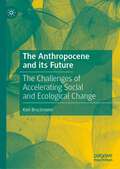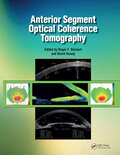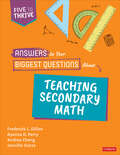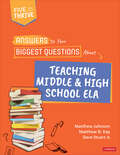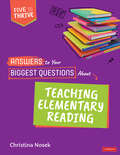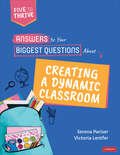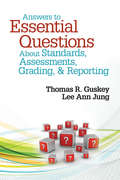- Table View
- List View
Antonio Stradivari (1644-1737): His Life And Work (1644-1737) (classic Reprint)
by W. Henry Hill Alfred E. Hill Arthur F. Hill, F.S.A.Delve into the fascinating world of violin making with "Antonio Stradivari: His Life and Work (1644-1737)" by W. Henry Hill, Arthur F. Hill, and Alfred E. Hill. This definitive biography offers an in-depth exploration of the life, craftsmanship, and enduring legacy of Antonio Stradivari, the most celebrated violin maker in history.Written by the renowned Hill family, experts in the field of string instruments, this meticulously researched work provides a comprehensive account of Stradivari’s remarkable career. From his early years in Cremona to his rise as the preeminent luthier of his time, the book paints a vivid portrait of Stradivari’s life, his workshop, and the cultural milieu in which he worked."Antonio Stradivari: His Life and Work" delves into the technical aspects of Stradivari’s craft, examining the design, materials, and methods that set his instruments apart. The Hill family’s expertise shines through in their detailed analysis of Stradivari’s violins, cellos, and other string instruments, offering insights into the genius behind their unparalleled sound quality and aesthetic beauty.Richly illustrated with photographs and diagrams, "Antonio Stradivari: His Life and Work" is both a visual and intellectual feast. The Hill family’s passion for and knowledge of their subject make this biography not only an authoritative reference but also an engaging and accessible read.This book is an essential resource for musicians, instrument makers, historians, and anyone interested in the art of violin making. "Antonio Stradivari: His Life and Work" stands as a testament to the enduring legacy of Stradivari’s craftsmanship and the timeless allure of his instruments.Join the Hill family on a journey through the life and work of Antonio Stradivari, and discover the secrets behind the masterpieces that have captivated the world for centuries.
Antiviral Agents, Vaccines, and Immunotherapies
by Stephen K. TyringUnlike any other source on the subject, Antiviral Agents, Vaccines, and Immunotherapies analyzes the benefits and limitations of every available drug, vaccine, and immunotherapy utilized in the prevention and control of viral diseases. This reference provides in-depth reviews of more than 50 drugs and antiviral agents for HIV, human herpesviruses,
Antimicrobials in Agriculture (Current Trends in Antimicrobial Research)
by Ram Prasad Arti GuptaThis book offers comprehensive coverage of all manifestations of resistance in combating infectious diseases and explores advances in antimicrobials in agriculture and their applications in the fight against microbes. According to the World Health Organization, antimicrobial resistance is a major threat to global health because the number of alternative antibiotics is very limited. Antimicrobial resistance is a slow, evolutionary process that has been accelerated by human activities in the health, environment, and agriculture sectors. Due to their wide application, antibiotics and their residues have been found in almost all food products and natural ecosystems. This book appraises the drivers, impact, and mitigation of antimicrobials, with a focus on methods and targets. In addition, it also provides a variety of photographs, diagrams, and tables to help illustrate the material. The novel strategies to combat antimicrobial resistance are also described, emphasizing collaborative measures of control. The underlying molecular mechanisms, which depend not only on the microbe but on the specific drug molecule, are highly diverse and are covered in detail.Students, researchers, scientists, practitioners, academicians, biologists, microbiologists, stakeholders, and policymakers can benefit from current trends in antimicrobials in agriculture that address microbiology, microbial biotechnology, ethnopharmacology, toxicology, natural medicinal plant products, secondary metabolites, and all disciplines related to antimicrobial research.Features of the book: Covers antimicrobials in agriculture with up-to-date research Recent references on plausible antimicrobials in agriculture Public health impact of the use of antibiotics in agriculture Antimicrobial efficacy of medicinal plants Role of phytoalexins in agriculture Nanoparticles as antimicrobial agents Presents cutting-edge research on microbiology, nanotechnology, and emergent antimicrobial technologies
Anti-VEGF Use in Ophthalmology
by Jay Duker Michelle LiangThe introduction of anti-vascular endothelial growth factor (VEGF) agents has revolutionized therapy for a host of ocular diseases associated with leakage from normal blood vessels and pathologic blood vessel growth. Anti-VEGF Use in Ophthalmology is an all-inclusive reference designed to provide detailed, up-to-date, and clinically relevant information on the current use of anti-VEGF agents in the treatment of all ocular conditions. Drs. Jay S. Duker and Michelle C. Liang have assembled a prestigious group of contributors who pool their collective expertise in this comprehensive book. Anti-VEGF Use in Ophthalmology is split into two sections with the first providing the history of VEGF and an overview of anti-VEGF agents and different routes of drug delivery, as it is important for eye care providers to be familiar with up-to-date aspects of the medications and indications for use. The second section details the clinical uses of anti-VEGF agents in numerous ocular diseases, from the anterior segment including cornea and glaucoma to uveitis and various retinal and choroidal diseases. Each chapter in this section summarizes the disease process and utilizes high-quality ocular imaging to demonstrate the therapeutic use of the anti-VEGF agents. Some of the topics covered in Anti-VEGF Use in Ophthalmology: Neovascular Age-Related Macular Degeneration Proliferative Diabetic Retinopathy Retinal Vein Occlusion Uveitis Neovascular Glaucoma Macular Edema Retinopathy of Prematurity Corneal Disease Anti-VEGF Use in Ophthalmology combines the theory and applications of anti-VEGF agents, making it not only a great learning tool for beginners but also a useful reference tool for a wide range of eye care professionals including optometrists, residents, comprehensive ophthalmologists, as well as specialists in anterior segment, pediatrics, and vitreoretinal disease.
The Anti-Journalist: Karl Kraus and Jewish Self-Fashioning in Fin-de-Siècle Europe (Studies In German-jewish Cultural Histor Ser.)
by Paul ReitterIn turn-of-the-century Vienna, Karl Kraus created a bold new style of media criticism, penning incisive satires that elicited both admiration and outrage. Kraus’s spectacularly hostile critiques often focused on his fellow Jewish journalists, which brought him a reputation as the quintessential self-hating Jew. The Anti-Journalist overturns this view with unprecedented force and sophistication, showing how Kraus’s criticisms form the center of a radical model of German-Jewish self-fashioning, and how that model developed in concert with Kraus’s modernist journalistic style.Paul Reitter’s study of Kraus’s writings situates them in the context of fin-de-siècle German-Jewish intellectual society. He argues that rather than stemming from anti-Semitism, Kraus’s attacks constituted an innovative critique of mainstream German-Jewish strategies for assimilation. Marshalling three of the most daring German-Jewish authors—Kafka, Scholem, and Benjamin—Reitter explains their admiration for Kraus’s project and demonstrates his influence on their own notions of cultural authenticity. The Anti-Journalist is at once a new interpretation of a fascinating modernist oeuvre and a heady exploration of an important stage in the history of German-Jewish thinking about identity.
The Anti-Inflammation Zone: Reversing the Silent Epidemic That's Destroying Our Health (The Zone)
by Barry SearsCombat silent inflammation --the most serious healththreat you never heard ofHeart disease is the #1 killer of Americans.Cancer is the #1 fear of Americans.Dementia is the #1 concern of Americans.What do these devastating illnesses have in common? All three have been linked to silent inflammation, a condition that occurs when the body's natural immune response goes awry. Silent inflammation can continue undetected for years, continually assaulting the heart, arteries, and even the brain -- and you will not even know it.New research confirms that obesity is a primary cause of silent inflammation. And inflammation is the smoking gun that links excess body fat to today's epidemic rise in heart disease, cancer, dementia, and countless other health threats. Although the science of this relationship is complex, the bottom line is simple: If not detected and reversed, silent inflammation will devastate generations of Americans and bankrupt an increasingly stressed health care system. The medical establishment appears to be ignorant about this problem, politicians don't talk about it -- and yet virtually everyone in the country is affected by it.In his number one New York Times bestseller The Zone, Dr. Barry Sears revolutionized the way we think about nutrition when he showed that a high-carbohydrate diet is a real risk to our health. Now, with eye-opening new research in the field of hormonal control and nutrition, Dr. Sears offers the first comprehensive plan to combat silent inflammation. This important book gives us the tools and tests we need to assess the current level of silent inflammation in our bodies -- and determine our future health.As you'll discover, the Zone dietary plan -- including supplements of high-dose, ultra-refined fish oil -- is the best way to get the hormonal control you need to reduce inflammation. In The Anti-Inflammation Zone, Dr. Sears shows exactly what steps to follow to reduce your risk of each disease and condition, or to reverse it if you have it already -- in only thirty days. And the Zone Lifestyle Program includes a week of delicious Zone-friendly meals, easy home exercises, and important stress-reducing methods -- all of which work together to put you on a path toward wellness that will improve the rest of your life.The day you start fighting silent inflammation is the day that you start to slow down the aging process -- and all the chronic diseases that come with it. Welcome to the Anti-Inflammation Zone -- and the return to wellness.
Anti-Europeanism, Populism and European Integration in a Historical Perspective (Critical European Studies)
by Andrea Guiso Daniele PasquinucciThis book explores the long-term origins of populist Euroscepticism.Taking a historical perspective to move beyond explaining present-day expressions of opposition to the European Union in isolation, this book reveals the historical sedimentation of the several ways and forms taken over decades by opposition towards European integration. As such, this approach – with contributions from across disciplines - explains not just the past of Euroscepticism, but also its current nature and future prospects.This book will be of key interest to scholars and students of European History, European Politics and Studies and more broadly to Political Science, International Relations, the Humanities and Social Sciences.
The Anti-Education Era: Creating Smarter Students through Digital Learning
by James Paul GeeOne of the first champions of the positive effects of gaming reveals the dark side of today's digital and social media Today's schools are eager to use the latest technology in the classroom, but rather than improving learning, the new e-media can just as easily narrow students' horizons. Education innovator James Paul Gee first documented the educational benefits of gaming a decade ago in his classic What Video Games Have to Teach Us About Learning and Literacy. Now, with digital and social media at the center of modern life, he issues an important warning that groundbreaking new technologies, far from revolutionizing schooling, can stymie the next generation's ability to resolve deep global challenges. The solution-and perhaps our children's future-lies in what Gee calls synchronized intelligence, a way of organizing people and their digital tools to solve problems, produce knowledge, and allow people to count and contribute. Gee explores important strategies and tools for today's parents, educators, and policy makers, including virtual worlds, artificial tutors, and ways to create collective intelligence where everyday people can solve hard problems. By harnessing the power of human creativity with interactional and technological sophistication we can finally overcome the limitations of today's failing educational system and solve problems in our high-risk global world. The Anti-Education Era is a powerful and important call to reshape digital learning, engage children in a meaningful educational experience, and bridge inequality.
Anthropology of the Middle East and North Africa: Into the New Millennium (Public Cultures Of The Middle East And North Africa Ser.)
by Sherine Hafez and Susan SlyomovicsThis volume combines ethnographic accounts of fieldwork with overviews of recent anthropological literature about the region on topics such as Islam, gender, youth, and new media. It addresses contemporary debates about modernity, nation building, and the link between the ideology of power and the production of knowledge. Contributors include established and emerging scholars known for the depth and quality of their ethnographic writing and for their interventions in current theory.
An Anthropology of Making in Santa Clara del Cobre: Presence of Absence
by Michele Avis Feder-NadoffThis book offers a nuanced reflection on the meaning of making and artisan agency, demonstrating how copper-smithing produces not only objects, but also lives, worlds, meanings, and social transformation. Through long-term ethnography, grounded in apprenticeship to master coppersmith Jesús Pérez Ornelas, Feder-Nadoff’s intimate description of communal and artisanal life in Santa Clara del Cobre, Michoacán, México provides a critical reappraisal of aesthetics and compelling ways to think about how aura and agency are produced. By mapping flows and frictions between persons, places, and things, this study closes the gap between economic and socio-political analysis of craft, on the one hand, and aesthetic, material, and phenomenological studies of making, on the other. Although craft historically plays a prominent national, even ideological role in Mexico, as in many countries, most artisans ironically remain absent, often living in marginalized, precarious circumstances. By tracing the cycles of life, death, and afterlife, of these maker-protagonists, their bodies of knowledge, skilled performances, and objects, this poetic monograph testifies to their presence.
Anthropology as Cultural Critique: An Experimental Moment in the Human Sciences
by George E. Marcus Michael M.J. FischerUsing cultural anthropology to analyze debates that reverberate throughout the human sciences, George E. Marcus and Michael M. J. Fischer look closely at cultural anthropology's past accomplishments, its current predicaments, its future direction, and the insights it has to offer other fields of study. The result is a provocative work that is important for scholars interested in a critical approach to social science, art, literature, and history, as well as anthropology. This second edition considers new challenges to the field which have arisen since the book's original publication.
Anthropological Expertise and Legal Practice: In Conversation (Law and Anthropology)
by Marie-Claire Foblets, Maria Sapignoli and Brian DonahoeThis book draws on concrete cases of collaboration between anthropologists and legal practitioners to critically assess the use of anthropological expertise in a variety of legal contexts from the point of view of the anthropologist as well as of the decision-maker or legal practitioner. The contributions, several of which are co-authored by anthropologist–legal practitioner tandems, deal with the roles of and relationships between anthropologists and legal professionals, which are often collaborative, interdisciplinary, and complementary. Such interactions go far beyond courts and litigation into areas of law that might be called ‘social justice activism’. They also entail close collaboration with the people –often subjects of violence and dispossession –with whom the anthropologists and legal practitioners are working. The aim of this collection is to draw on past experiences to come up with practical methodological suggestions for facilitating this interaction and collaboration and for enhancing the efficacy of the use of anthropological expertise in legal contexts. Explicitly designed to bridge the gap between theory and practice, and between scholarship and practical application, the book will appeal to scholars and researchers engaged in anthropology, legal anthropology, socio-legal studies, and asylum and migration law. It will also be of interest to legal practitioners and applied social scientists, who can glean valuable lessons regarding the challenges and rewards of genuine collaboration between legal practitioners and social scientists.
The Anthropocene and its Future: The Challenges of Accelerating Social and Ecological Change
by Karl BruckmeierThis book analyses the complex social and ecological processes of the Great Acceleration, the Great Transformation, and sustainable development that shape the future of the global society in the twenty-first century. The first process takes place for a longer time, the second over the past thirty years, with attempts to build a sustainable economy and society in the global policy of sustainable development. The processes and their interaction will be discussed with knowledge from inter- and transdisciplinary transformation research, social and political ecology, and theories of modern society. The guiding theoretical concepts for the social-ecological transformation will be clarified: the concepts of acceleration, transformation, and sustainable development, and the societal and ecological processes they include. To obtain a more detailed picture of the changes in the global social-ecological system, different parts of the global transformation, the digital transformation, the transformation of food systems, and the transformation of modes of living in the social lifeworld are described to show the complex changes in the epoch of the Anthropocene more concretely. The global change processes in society and nature are caused by human forces but are difficult to control through policy and governance. With the interdisciplinary integration of concepts and knowledge, it becomes possible to provide a more detailed picture, of the difficulties to achieve a sustainable future society.
Anterior Segment Optical Coherence Tomography
by David Huang Roger SteinertHigh-speed anterior segment optical coherence tomography (OCT) offers a non-contact method for high resolution cross-sectional and three-dimensional imaging of the cornea and the anterior segment of the eye. As the first text completely devoted to this topic, Anterior Segment Optical Coherence Tomography comprehensively explains both the scientific principles and the clinical applications of this exciting and advancing technology.Anterior Segment Optical Coherence Tomography enhances surgical planning and postoperative care for a variety of anterior segment applications by expertly explaining how abnormalities in the anterior chamber angle, cornea, iris, and lens can be identified and evaluated using the Visante OCT™.Inside Anterior Segment Optical Coherence Tomography, Dr. Roger Steinert and Dr. David Huang, along with 22 of the field's leading professionals, provide a wealth of useful clinical and physiological material about this new diagnostic imaging technique. Valuable images are included to assist in the pre- and postoperative assessment of various anterior segment disorders. Additionally, this unique resource contains detailed information on biometric measurements to enhance diagnostic capability.On the leading edge of anterior segment imaging: Mapping of corneal thickness and keratoconus evaluation Measurement of LASIK flap and stromal bed thickness Visualization and measurement of anterior chamber angle and diagnosis of narrow angle glaucoma Measuring the dimensions of the anterior chamber and assessing the fit of intraocular lens implants Visualizing and measuring the results of corneal implants and lamellar procedures Imaging through corneal opacity to see internal eye structures With the increase in popularity of anterior chamber imaging, and anterior segment OCT proving to be the best tool for high resolution biometry, Anterior Segment Optical Coherence Tomography is a must-have for anterior segment, refractive, cornea, and glaucoma surgeons.
Antarastriya Sambandagala Saidantika Amshagalu: ಅಂತರಾಷ್ಟೀಯ ಸಂಬಂಧಗಳ ಸೈದಾಂತಿಕ ಅಂಶಗಳು
by Boramma H Angadiಇದು ಅಂತರಾಷ್ಟೀಯ ಸಂಬಂಧಗಳ ಸೈದಾಂತಿಕ ಅಂಶಗಳು DSC 13 NEP ಪಠ್ಯಕ್ರಮದ ಪ್ರಕಾರ BA ಕನ್ನಡ ಮಾಧ್ಯಮದ ವಿದ್ಯಾರ್ಥಿಗಳಿಗೆ ಹಾಗೂ ಸ್ನಾತಕೋತ್ತರ ವಿದ್ಯಾರ್ಥಿಗಳಿಗೆ, ಸ್ಪರ್ಧಾತ್ಮಕ ಪರೀಕ್ಷೆಗಳಿಗೆ ಅಧ್ಯಯನ ಮಾಡಲು ಈ ಪುಸ್ತಕವು ಸಹಾಯಕವಾಗಿದೆ.
Answers to Your Biggest Questions About Teaching Secondary Math: Five to Thrive [series] (Corwin Mathematics Series)
by Frederick L. Dillon Ayanna D. Perry Andrea Negrete Cheng Jennifer OutzsLet’s face it, teaching secondary math can be hard. So much about how we teach math today may look and feel different from how we learned it. Teaching math in a student-centered way changes the role of the teacher from one who traditionally "delivers knowledge" to one who fosters thinking. Most importantly, we must ensure our practice gives each and every student the opportunity to learn, grow, and achieve at high levels, while providing opportunities to develop their agency and authority in the classroom which results in a positive math identity. Whether you are a brand new teacher or a veteran, if you find teaching math to be quite the challenge, this is the guide you want by your side. Designed for just-in-time learning and support, this practical resource gives you brief, actionable answers to your most pressing questions about teaching secondary math. Written by four experienced math educators representing diverse experiences, these authors offer the practical advice they wish they received years ago, from lessons they′ve learned over decades of practice, research, coaching, and through collaborating with teams, teachers and colleagues—especially new teachers—every day. Questions and answers are organized into five areas of effort that will help you most thrive in your secondary math classroom: How do I build a positive math community? How do I structure, organize, and manage my math class? How do I engage my students in math? How do I help my students talk about math? How do I know what my students know and move them forward? Woven throughout, you′ll find helpful sidebar notes on fostering identity and agency; access and equity; teaching in different settings; and invaluable resources for deeper learning. The final question—Where do I go from here?— offers guidance for growing your practice over time. Strive to become the best math educator you can be; your students are counting on it! What will be your first step on the journey?
Answers to Your Biggest Questions About Teaching Secondary Math: Five to Thrive [series] (Corwin Mathematics Series)
by Frederick L. Dillon Ayanna D. Perry Andrea Negrete Cheng Jennifer OutzsLet’s face it, teaching secondary math can be hard. So much about how we teach math today may look and feel different from how we learned it. Teaching math in a student-centered way changes the role of the teacher from one who traditionally "delivers knowledge" to one who fosters thinking. Most importantly, we must ensure our practice gives each and every student the opportunity to learn, grow, and achieve at high levels, while providing opportunities to develop their agency and authority in the classroom which results in a positive math identity. Whether you are a brand new teacher or a veteran, if you find teaching math to be quite the challenge, this is the guide you want by your side. Designed for just-in-time learning and support, this practical resource gives you brief, actionable answers to your most pressing questions about teaching secondary math. Written by four experienced math educators representing diverse experiences, these authors offer the practical advice they wish they received years ago, from lessons they′ve learned over decades of practice, research, coaching, and through collaborating with teams, teachers and colleagues—especially new teachers—every day. Questions and answers are organized into five areas of effort that will help you most thrive in your secondary math classroom: How do I build a positive math community? How do I structure, organize, and manage my math class? How do I engage my students in math? How do I help my students talk about math? How do I know what my students know and move them forward? Woven throughout, you′ll find helpful sidebar notes on fostering identity and agency; access and equity; teaching in different settings; and invaluable resources for deeper learning. The final question—Where do I go from here?— offers guidance for growing your practice over time. Strive to become the best math educator you can be; your students are counting on it! What will be your first step on the journey?
Answers to Your Biggest Questions About Teaching Middle and High School ELA: Five to Thrive [series] (Corwin Literacy)
by Matthew Johnson Dave Stuart Matthew R. Kay"Matthew Johnson, Dave Stuart Jr., and Matthew R. Kay have written a book to help navigate the burning questions early career teachers long to understand. From ways to build a community of learners to motivational instruction to feedback that works for students and teachers alike, these inspirational teachers share what it takes to craft a career for the long haul." - Andy Schoenborn, co-author of Creating Confident Writers: For High School, College, and Life Your guide to grow and learn as an ELA teacher! Let’s face it, major shifts over the past decade, including pandemic-related challenges, have rapidly changed our ELA classrooms. New and experienced teachers can benefit from guidance on the fundamentals of what excellent teaching and learning of writing can look like. Friendly and practical, this book is a reminder of the things that matter most. Part of the Five to Thrive series for early-career educators, Answers to Your Biggest Questions About Teaching Middle & High School ELA offers solutions for any teacher who wishes to refresh their practice. Questions and answers are organized into five areas that will help you thrive in your classroom: How do I build a brave, supportive reading and writing community? How do I cultivate motivation? How can I ensure that my feedback and assessment are efficient, effective, and equitable? What does strong ELA instruction look like? How can I keep doing this for my whole career? The authors, all practicing ELA educators, provide solutions to the most urgent challenges teachers face in providing student-centered and efficient instruction. With an emphasis on equity, culturally responsive practice, and intrinsic motivation, the book focuses on the wellbeing of both students and teachers. You’ll find accessible tips for immediate use woven throughout. Strive to be the best ELA educator you can; your students are counting on it!
Answers to Your Biggest Questions About Teaching Middle and High School ELA: Five to Thrive [series] (Corwin Literacy)
by Matthew Johnson Dave Stuart Matthew R. Kay"Matthew Johnson, Dave Stuart Jr., and Matthew R. Kay have written a book to help navigate the burning questions early career teachers long to understand. From ways to build a community of learners to motivational instruction to feedback that works for students and teachers alike, these inspirational teachers share what it takes to craft a career for the long haul." - Andy Schoenborn, co-author of Creating Confident Writers: For High School, College, and Life Your guide to grow and learn as an ELA teacher! Let’s face it, major shifts over the past decade, including pandemic-related challenges, have rapidly changed our ELA classrooms. New and experienced teachers can benefit from guidance on the fundamentals of what excellent teaching and learning of writing can look like. Friendly and practical, this book is a reminder of the things that matter most. Part of the Five to Thrive series for early-career educators, Answers to Your Biggest Questions About Teaching Middle & High School ELA offers solutions for any teacher who wishes to refresh their practice. Questions and answers are organized into five areas that will help you thrive in your classroom: How do I build a brave, supportive reading and writing community? How do I cultivate motivation? How can I ensure that my feedback and assessment are efficient, effective, and equitable? What does strong ELA instruction look like? How can I keep doing this for my whole career? The authors, all practicing ELA educators, provide solutions to the most urgent challenges teachers face in providing student-centered and efficient instruction. With an emphasis on equity, culturally responsive practice, and intrinsic motivation, the book focuses on the wellbeing of both students and teachers. You’ll find accessible tips for immediate use woven throughout. Strive to be the best ELA educator you can; your students are counting on it!
Answers to Your Biggest Questions About Teaching Elementary Reading: Five to Thrive [series] (Corwin Literacy)
by Christina NosekTeach reading right with just-in-time expert advice! Whether you’re new to teaching reading or if you are a veteran whose goal is to focus on authentic reading instruction, this book is designed to be an on-the-desk companion, providing answers to your burning teaching questions at the moment you most need them. A lot has changed in reading instruction over the past decades, with old assumptions and tired curricula making way for both trusted and new best practices. Answers to Your Biggest Questions About Teaching Elementary Reading, written by a veteran teacher who’s an expert in literacy instruction, offers research-backed, classroom-tested guidance to set you on the right path. Through practical teaching strategies, classroom examples, actionable steps, further reading suggestions, and more, you’ll learn to Build and maintain an inclusive, equitable classroom reading community Structure, organize, and plan student-centered, responsive reading instruction Design and implement compassionate, effective assessment methods Engage and empower students to develop agency as readers You became a teacher to teach students—not curriculum. With this indispensable book by your side, you’ll develop practices that prioritize student well-being and success.
Answers to Your Biggest Questions About Teaching Elementary Reading: Five to Thrive [series] (Corwin Literacy)
by Christina NosekTeach reading right with just-in-time expert advice! Whether you’re new to teaching reading or if you are a veteran whose goal is to focus on authentic reading instruction, this book is designed to be an on-the-desk companion, providing answers to your burning teaching questions at the moment you most need them. A lot has changed in reading instruction over the past decades, with old assumptions and tired curricula making way for both trusted and new best practices. Answers to Your Biggest Questions About Teaching Elementary Reading, written by a veteran teacher who’s an expert in literacy instruction, offers research-backed, classroom-tested guidance to set you on the right path. Through practical teaching strategies, classroom examples, actionable steps, further reading suggestions, and more, you’ll learn to Build and maintain an inclusive, equitable classroom reading community Structure, organize, and plan student-centered, responsive reading instruction Design and implement compassionate, effective assessment methods Engage and empower students to develop agency as readers You became a teacher to teach students—not curriculum. With this indispensable book by your side, you’ll develop practices that prioritize student well-being and success.
Answers to Your Biggest Questions About Creating a Dynamic Classroom: Five to Thrive [series] (Corwin Teaching Essentials)
by Serena Pariser Victoria S. Lentfer"Serena Pariser and Victoria Lentfer provide answers to common questions that linger in the brain of a newer teacher. As a newer teacher myself, I wish a book like this existed when I started out. This book is engaging, informative, and so much more. Each section includes helpful tips and is easily organized and accessible. This book is truly an amazing guide for newer teachers, and I highly recommend it as it will form the perfect basis for that exciting and powerful start of a new journey. Teaching can be many things, but this book is truly a game changer for anyone starting out." —Susan Jachymiak Teacher, Leader, and Author Create a positive and energetic classroom where learning can flourish. This insightful, friendly guide to establishing a dynamic classroom is a lifeline of practical support for teachers, providing answers to your biggest questions at the moment you most need them. Through instructional tools, teaching tips, classroom examples, reading suggestions, and more, Answers to Your Biggest Questions about Creating a Dynamic Classroom equips teachers to embark on the path of success toward building a positive and energetic learning environment. It details brief, actionable answers to your most pressing questions in five areas of effort: How do I build an affirming classroom community? How do I keep students at the center? How can I design effective, fun, and engaging learning for students? How can I make assessments work for me and my students? What are the things I need to know that are rarely discussed in a teacher training program? This is a resource to keep handy on your desk and reach for often for establishing a vibrant and welcoming classroom community. Practical guidance on topics such as communicating with parents, asking for administrator support, and maintaining a work/life balance, help teachers not only succeed in the early years of teaching, but thrive.
Answers to Your Biggest Questions About Creating a Dynamic Classroom: Five to Thrive [series] (Corwin Teaching Essentials)
by Serena Pariser Victoria S. Lentfer"Serena Pariser and Victoria Lentfer provide answers to common questions that linger in the brain of a newer teacher. As a newer teacher myself, I wish a book like this existed when I started out. This book is engaging, informative, and so much more. Each section includes helpful tips and is easily organized and accessible. This book is truly an amazing guide for newer teachers, and I highly recommend it as it will form the perfect basis for that exciting and powerful start of a new journey. Teaching can be many things, but this book is truly a game changer for anyone starting out." —Susan Jachymiak Teacher, Leader, and Author Create a positive and energetic classroom where learning can flourish. This insightful, friendly guide to establishing a dynamic classroom is a lifeline of practical support for teachers, providing answers to your biggest questions at the moment you most need them. Through instructional tools, teaching tips, classroom examples, reading suggestions, and more, Answers to Your Biggest Questions about Creating a Dynamic Classroom equips teachers to embark on the path of success toward building a positive and energetic learning environment. It details brief, actionable answers to your most pressing questions in five areas of effort: How do I build an affirming classroom community? How do I keep students at the center? How can I design effective, fun, and engaging learning for students? How can I make assessments work for me and my students? What are the things I need to know that are rarely discussed in a teacher training program? This is a resource to keep handy on your desk and reach for often for establishing a vibrant and welcoming classroom community. Practical guidance on topics such as communicating with parents, asking for administrator support, and maintaining a work/life balance, help teachers not only succeed in the early years of teaching, but thrive.
Answers to Essential Questions About Standards, Assessments, Grading, and Reporting
by Lee Ann Jung Thomas R. GuskeyThe definitive guidebook to the complex terrain of 21st-century standards!Standards, assessments, grading, and reporting provide the foundation for nearly every initiative in modern education reform. But what do these terms actually mean—and what changes in each area will bring about the improvements teachers and school leaders want to see? Here, Thomas R. Guskey and Lee Ann Jung collect the essential questions that stymie educators, and give each one a short, simple, jargon-free response.Perfect for new teacher induction or professional learning on Common Core Standards initiatives, this book offers:A vocabulary and frame of reference to share with other educatorsAn understanding of effective implementation in standards, assessments, grading, and reportingSpecific ideas for purposeful actionOrganized in a unique, accessible Q&A format, this easy-to-use guide gives educators the common ground they need for successful improvement efforts."This text is a useful tool that educators can use to build common definitions about frequently used and misunderstood educational terms within their state, district, or school. Only when educators have the same understanding of ′formative assessment′ or ′grade reporting′ can they be implemented with fidelity."—Julie Quinn, Accountability SpecialistUtah State Office of Education, Salt Lake City, UT"Written in small sections, this book explains well how we assess, why we use different assessments, and asks guiding questions for application of assessments. I highly recommend this book for anyone interested in educational assessments."—Jeanne Collins, SuperintendentBurlington School District, VT
Answers to Essential Questions About Standards, Assessments, Grading, and Reporting
by Lee Ann Jung Thomas R. GuskeyThe definitive guidebook to the complex terrain of 21st-century standards!Standards, assessments, grading, and reporting provide the foundation for nearly every initiative in modern education reform. But what do these terms actually mean—and what changes in each area will bring about the improvements teachers and school leaders want to see? Here, Thomas R. Guskey and Lee Ann Jung collect the essential questions that stymie educators, and give each one a short, simple, jargon-free response.Perfect for new teacher induction or professional learning on Common Core Standards initiatives, this book offers:A vocabulary and frame of reference to share with other educatorsAn understanding of effective implementation in standards, assessments, grading, and reportingSpecific ideas for purposeful actionOrganized in a unique, accessible Q&A format, this easy-to-use guide gives educators the common ground they need for successful improvement efforts."This text is a useful tool that educators can use to build common definitions about frequently used and misunderstood educational terms within their state, district, or school. Only when educators have the same understanding of ′formative assessment′ or ′grade reporting′ can they be implemented with fidelity."—Julie Quinn, Accountability SpecialistUtah State Office of Education, Salt Lake City, UT"Written in small sections, this book explains well how we assess, why we use different assessments, and asks guiding questions for application of assessments. I highly recommend this book for anyone interested in educational assessments."—Jeanne Collins, SuperintendentBurlington School District, VT
